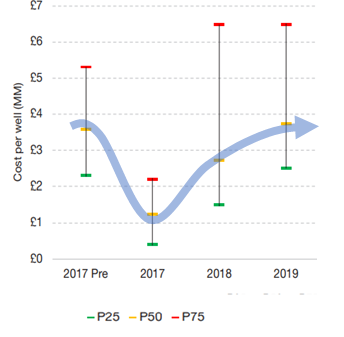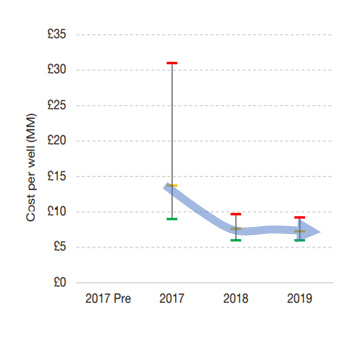Technology Streams to Deliver Rigless P&A
THE ROLE OF TECHNOLOGY IN DELIVERING THE UKCS DECOMMISSIONING COST CHALLENGE
The Oil and Gas Authority has challenged industry to reduce overall UKCS decommissioning by over 35% from the 2017 baseline estimate. Well P&A is estimated to account for circa 45% of the total basin decommissioning cost estimate, however, analysis of industry data indicates that the cost of decommissioning both platform and subsea wells has remained stubbornly stable.
Platform well P&A cost (NNS/CNS)

Subsea well P&A cost (NNS/CNS)

analysis of industry reported well decommissioning cost up to 2019 revealed that while cost reduction had been achieved in other decommissioning areas, well P&A costs were not seeing a similar impact.
Charts courtesy of NSTA
Conventional approaches to well abandonment typically requires the use of a platform or mobile rig for recovery of the upper completion tubing and equipment in order to set cement plugs as part of a barrier to restore cap rock integrity and prevent unintended release of fluids (hydrocarbons and formation water) from the reservoir or other permeable strata capable of flow to surface.
Technologies are being developed and brought to market which where applicable will allow “rig-less” approaches to well decommissioning using lower cost assets (intervention masts and towers, work class vessels) or more efficient use of assets (Light Well Intervention vessels and intervention semisubmersibles) to reduce the duration of some abandonments helping to bring down costs.
The capability to execute alternative approaches to rig based well decommissioning more widely is growing with the emergence of new technology solutions, however, to increase the application of fully “rig-less” well decommissioning requires confidence by both operators and regulators in the performance of the technology involved in the work programmes.
Through the Industry Sponsored Programme the TLB is tasking industry to secure opportunities for field trials of developing technologies needed for “rig-less” P&A to demonstrate and refine deployment, operation, data analysis/interpretation and furthermore to better understand the integration of the various technical solutions required to deliver a fully rig-less abandonment.